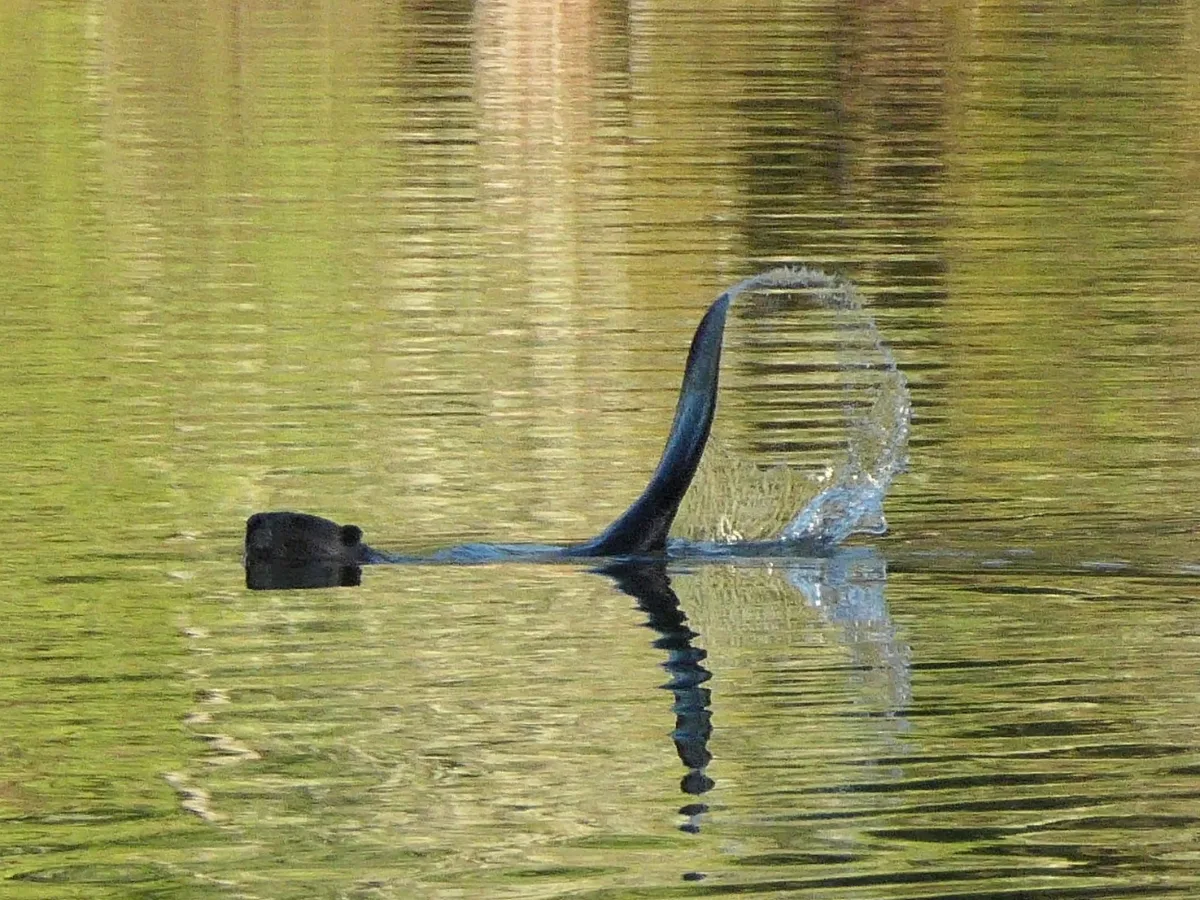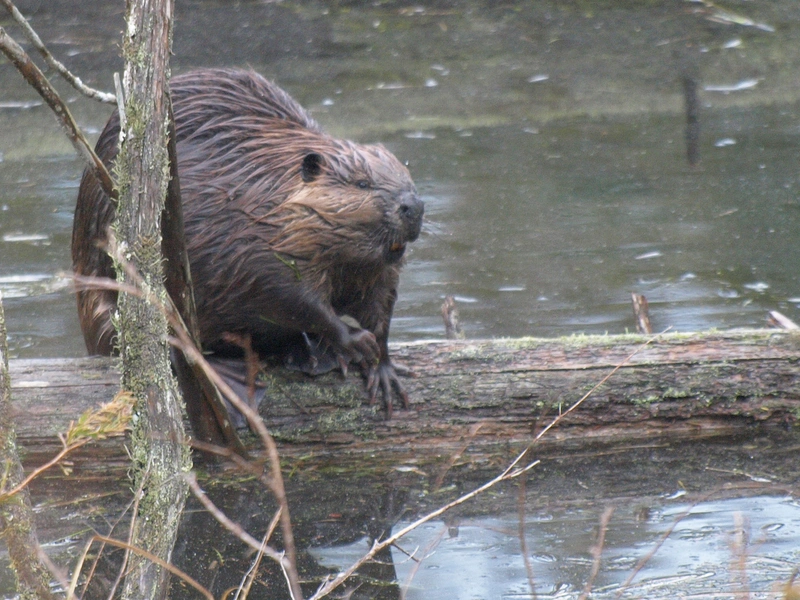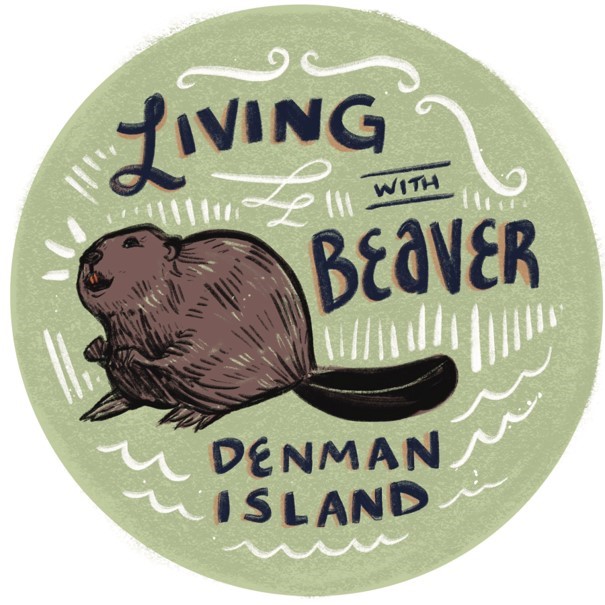While DCA volunteers work tirelessly to preserve, protect and enhance the quality of the human and natural environment on Denman, beavers truly give us a run for our money as the island’s most effective water conservationists.
Beaver-dependent wetlands and waterways are found all over Denman, with at least 18 beaver dams on large lakes and wetlands. These beaver-engineered bodies of water not only support our household water-use by retaining surface water and replenishing groundwater supplies. They also support salmon spawns and contribute to Denman’s rich biodiversity, which includes at least 25 species at risk.
While beavers can get a bad rap in relation to flooding and tree damage, their dams are actually key in keeping water access stable. They’ve played a significant role in shaping Denman’s ecosystems, generating wetlands that are crucial in getting the island’s human inhabitants through drought conditions and helping cut off the spread of forest fires by creating natural fire breaks. If beavers disappear, their dams eventually break down, which leads to down-stream flooding, a reduction of available water, and the loss of vital habitat.
In 2023, the Denman Living with Beaver project team explored the scope of beaver conflict issues on Denman while also investigating future solutions, with the goal of helping islanders to more comfortably cohabit with beaver neighbours, while also reaping the benefits of their presence.
Learn more about the project on the Denman Living with Beaver project page.
Living With Beaver Project
This year, the only creatures as busy as beavers might have been the members of the Denman Island Living with Beaver project! This project was coordinated by Denman Conservancy Association with support from the Habitat Conservation Trust Foundation. A small team of beaver biology enthusiasts sought out to identify and document beaver activities and human-beaver conflicts on Denman, learning more about our local beavers and paving the way for solutions that are both human- and beaver-friendly in the future.
Beginning May 2023, the beaver team reached out to the community to help determine where beavers are living on Denman Island, and what they’re up to. They collected information about beaver activity and sightings from across Denman, through the Denman Freemail, email, and conversations at public events. They also tracked beaver activity through our Denman Island Living with Beaver iNaturalist project page, which you can continue to add sightings to.
Having a beaver for a neighbour is not always easy, so the team also investigated a range of solutions to help Denman residents who are experiencing busy beaver problems. Whether it’s mitigating flooding or keeping apple trees alive, check out our beaver subpages for more information on best practices for co-existing with beavers while protecting property, infrastructure, and even other species.
While March 2024 marks the end of this initial seed stewardship project, the DCA hopes to continue and grow this work well into the future to help Denman Islanders to coexist with these toothy engineers.
Thanks for giving a dam, Denman!
Beavers are a Salmon’s Best Friend
Beavers have been long mistaken as just another hurdle for salmon on their epic journey to their natal streams and rivers to spawn, but Canada’s largest rodent is actually a misunderstood ally to salmon populations.
When early studies found evidence that beaver dams impede their passage, it became common practice for well-meaning fishery managers to remove dams under the assumption that this would help salmon. But as researchers began to dive deeper into the complex relationships between these keystone species while also finally acknowledging Indigenous understanding of salmon-beaver relations, the view of beavers as salmon adversaries took a dramatic turn.
While it’s rare for a beaver dam to completely block fish passage upstream, they can cause delays, with salmon sometimes left waiting for days or even weeks until the water level is deep enough to propel themselves over dams. But being forced to wait for higher water flows is just what their offspring will need. Young salmon would otherwise struggle to survive without beaver’s engineering side channels and deeper pools. Not only do they help baby salmon stay cool during heat waves and droughts, beaver-managed waters also provide more food and better hiding spots.
Beaver dams may be a short-term inconvenience to salmon, but the impacts of tampering with one are much longer term. When upstream water flows faster, the young salmon already in those waters face a less certain future as their habitat degrades. Juvenile salmon can even be swept downstream during winter storms without beaver infrastructure to slow the flow.
Salmon have long traversed streams and rivers punctuated with beaver dams all along the way, having coexisted alongside beaver for millennia until beavers were nearly wiped out thanks to the fur trade. Only after salmon populations began to suffer significantly from human activity did we turn to quick fixes for their precarious situation. In addition to overfishing, climate change is one of their biggest threats, increasing water temperatures and the frequency and intensity of droughts. Culverts and bridges also create pinch points that beavers still feel compelled to block, so the most problematic beaver dams are typically those found in waterways already negatively impacted by human infrastructure. Despite humans being the common denominator in all these issues, the helpful beaver is unfortunately often left to take the fall.
Beaver-Friendly Solutions
Leave it to beavers to give salmon a helping hand. Not only are there negative consequences to tampering with their dams, but it’s also illegal. Luckily, in the rare instances where salmon truly need help getting by, fish-friendly flow devices can be installed. If you suspect salmon are struggling to get by a particular beaver dam, let the Denman Conservancy Association’s Living with Beaver team know. We can assess the situation and provide support where possible.
Protecting Trees from Beavers
While they might not spend their time canning fruits or pulling sweaters out of storage, beavers work hard to secure a comfortable winter all the same. Throughout the summer, beavers mostly eat freshwater plants like water lilies, but autumn is when they shift their attention to woodier grub. Not only do they begin munching on tree bark for everyday meals, this time of year they’re also in winter planning mode, maintaining or building new lodges and dams, and even stockpiling branches underwater where winters are harsh.
This is also when beavers can become problematic neighbours. While beavers play a key role in retaining surface water and replenishing groundwater supplies, no one wants to see their fruit or shade trees downed for the sake of a dam. It might seem that removing beavers would remove the problem, but in reality removal only provides temporary relief. When a vacancy opens up in a suitable habitat, young beavers that live nearby actually reach sexual maturity faster than they would otherwise. That means new beaver families will quickly fill in the gaps, and the same issues will eventually return.
Beaver-Friendly Solutions
Luckily, there are great workarounds that allow us to still reap the benefits of having beaver neighbours, without losing important trees. Placing wire cage cylinders around the base of tree trunks does wonders at keeping them away, and using the right gauge mesh makes for a permanent solution. If you’re not a fan of the look of wire wrapped trees and don’t mind adding a task to your to-do list, you can go after their taste buds instead, painting the lower trunks with a mixture of cayenne pepper and vegetable oil.
If you’re looking for more information on how to best protect your trees from toothy neighbours, reach out to the Denman Island Living with Beaver team.
Nature’s Skilled Firefighter: the Beaver
In need of forest fire solutions? Look no further than the humble beaver.
2023 was Canada’s worst wildfire season on record, with millions of hectares burned across the country. Amongst all the devastation, some of the few places that remained green were beaver-created wetlands.
Beavers are unique in how they slow water. Their bow-shaped dams encourage water to not only spread out and soak the surrounding landscape but also raise the water table. Beavers also dig out channels to access trees farther from the water’s edge, spreading water further. Spring rains and snow melt that would usually rush away and cause erosion is instead stored for the dry summer months when water is scarce. The gently sloping sides of beaver marshes are perfect for water-loving trees like willows, alders, and maples; all trees that act as natural fire breaks, giving firefighters a chance for containment.
Beaver dams provide critical habitats for plants and animals to live and thrive in, including endangered species. This is especially valuable during wildfires, as beaver dams create temporary habitats for wild animals who are unable to escape from the threat of rapidly advancing fires. Areas that are not damaged by fire help heal fire-ravaged landscapes by acting as a ‘seed ecosystem’, from which species can spread out and populate the area more easily after the fire passes. The ecosystems that beavers create are so effective at restoring wetlands, retaining water, and fighting fires that land managers are now mimicking their structures. But the most effective structures are those built by the rodents themselves.
From droughts to wildfires to a biodiversity crisis, beavers are the superheroes we need to respond to the call.
A key Actor in tackling multi-faceted issues
Extreme weather, forest fires, biodiversity loss, drought… the world is facing multiple crises that are changing the places we live. Much work is being done to tackle these issues, but one key actor often goes unnoticed:

The humble beaver! Beavers expertly engineer dams to keep water on the land, stabilizing environments, and providing refuge for other critters. They even support local food security.
Denman Conservancy works to protect natural areas that provide habitat for climate heroes like beavers. Many of Denman Island’s protected places feature wetlands, and many of these wetlands are maintained through the activities of beavers.

In 2021, for the Mark A. Isfeld High School Ecofair, Denman Conservancy collaborated with student filmmaker Lucy Dabbs to create this short film: https://vimeo.com/518433010
Existing Blog post with good text to take for Page: https://www.denmanconservancy.org/2023/04/09/denman-living-with-beaver-project/


